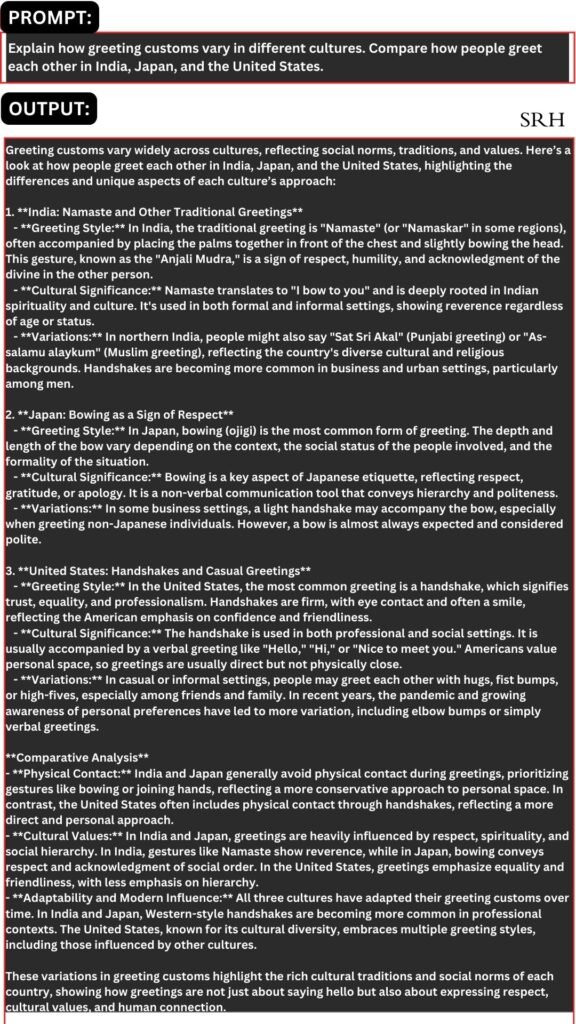In today’s globalization era, cross-cultural communication is a must-have skill. It helps you connect with people from different backgrounds and understand their perspectives. For Indian high school students, this is especially important. Whether you are planning to study abroad or work in a multinational company, these skills will give you an edge.
So, how do you develop cross-cultural communication skills? One effective way is to use ChatGPT with the right prompts. These prompts can guide you through different scenarios, helping you practice and improve. However, crafting effective inputs to ChatGPT is quite a hectic task for a student. Don’t worry! It’s my duty to help you, my dear children.
In this blog post, I provide a few ready-to-use awesome ChatGPT prompts for a quick start. Let’s dive into the cross-culture communication prompts, customized for high school grades.
Understanding Cultural Differences
Before diving into communication, it’s important to understand cultural differences. Different cultures have unique customs, values, and communication styles. Being aware of these differences can prevent misunderstandings and build stronger connections.
Prompt Example:
“Explain how greeting customs vary in different cultures. Compare how people greet each other in India, Japan, and the United States.”
This prompt, for example, encourages you to explore and compare greeting customs. So, by doing this, you become more aware of how to approach people from different cultures.
Now, see the output to the above prompt:

Practicing Active Listening
Active listening is crucial in cross-cultural communication. It involves fully focusing on the speaker, understanding their message, and responding thoughtfully. In a cross-cultural context, it also means paying attention to non-verbal cues.
Prompt Example:
“Create a dialogue between two people from different cultures. Focus on how they practice active listening, especially when they face language barriers.”
This prompt helps you practice listening skills in a cross-cultural setting. It makes you aware of the challenges and teaches you how to overcome them.
Handling Misunderstandings
Misunderstandings are common in cross-cultural communication. They can arise from differences in language, customs, or beliefs. Learning how to handle these misunderstandings is key to maintaining good relationships.
Prompt Example:
“Describe a situation where a misunderstanding occurred due to cultural differences. How was it resolved, and what could have been done to prevent it?” [Insert the situation]
This prompt encourages you to think about real-life scenarios. By analyzing them, you can learn how to prevent and resolve similar issues in the future.
For example, see the following prompt and respective output:

Adapting Your Communication Style
Adapting your communication style to fit the cultural context is essential. Some cultures prefer direct communication, while others value indirectness. Knowing when and how to adapt can make your communication more effective.
Prompt Example:
“Discuss how you would adapt your communication style when speaking with someone from a high-context culture (like Japan) versus a low-context culture (like Germany).”
This prompt challenges you to think about how you would change your communication approach based on cultural context.
Building Empathy and Respect
Empathy and respect are at the heart of cross-cultural communication. Understanding and valuing the perspectives of others can lead to more meaningful interactions.
Prompt Example:
“Write a story where two characters from different cultural backgrounds build a friendship. Focus on how they show empathy and respect for each other’s customs.”
This prompt allows you to explore how empathy and respect can bridge cultural divides. It also gives you a chance to practice writing scenarios that highlight these qualities.
Practising Non-Verbal Communication
Surely, non-verbal communication is just as important as verbal communication. Because, gestures, facial expressions, and body language convey different meanings in different cultures.
Prompt Example:
“Create a scenario where non-verbal communication leads to a misunderstanding between people from two different cultures. Explain how they resolved the issue.”
This prompt helps you understand the impact of non-verbal cues in cross-cultural communication. It also encourages you to think about how to resolve issues that arise from these differences.
Navigating Power Distance
Power distance refers to how a culture views hierarchy and authority. In some cultures, there’s a high power distance, meaning people respect and defer to authority figures. In others, power distance is low, and equality is valued.
Prompt Example:
“Imagine you’re working on a group project with people from a culture with high power distance. How would you approach decision-making and discussions in this context?”
This prompt, for example, helps you think about how to navigate cultural differences in power dynamics. It teaches you to be mindful of how these differences affect communication.
Engaging in Cultural Exchange
Cultural exchange involves sharing and learning about each other’s cultures. It’s also a great way to build cross-cultural communication skills and create mutual understanding.
Prompt Example:
“Design a cultural exchange event between students from India and another country. Describe activities that would help them learn about each other’s cultures.”
This prompt encourages you to think about how to create meaningful cultural exchanges. It also helps you understand what activities can foster learning and connection.
Reflecting on Your Own Culture
Certainly, understanding your own culture is just as important as learning about others. Reflecting on your cultural values, beliefs, and communication style can also help you better understand how you interact with others.
Prompt Example:
“Reflect on your own cultural background. How do your cultural values influence your communication style? Compare it with another culture.”
This prompt, for example, helps you gain insight into your own cultural identity. It also allows you to compare it with others, enhancing your cross-cultural understanding.
Conclusion: Becoming a Cross-Cultural Communicator
In conclusion, developing cross-cultural communication skills is a journey. It requires awareness, practice, and a willingness to learn. But, by using these ChatGPT prompts, you can start this journey and build the skills you need to succeed in a globalized world.
However, the goal is not just to communicate but to connect. But, understanding and respecting cultural differences will make your communication more meaningful and effective.
So, start practising today, and watch your cross-cultural communication skills grow! Surely, you’ll succeed in this journey.
Good Luck! Dear.





